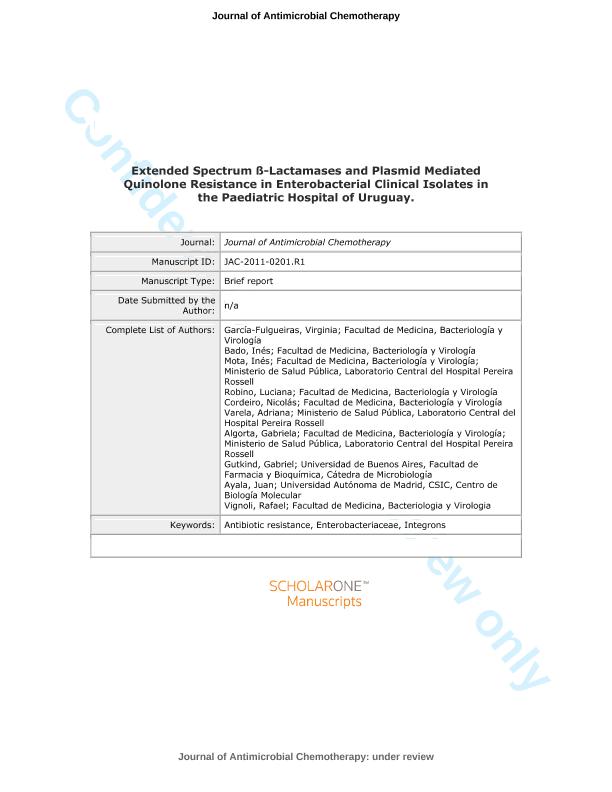Artículo
Extended-spectrum β-lactamases and plasmid-mediated quinolone resistance in enterobacterial clinical isolates in the paediatric hospital of Uruguay
García Fulgueiras, Virginia; Bado, Inés; Mota, María Inés; Robino, Luciana; Cordeiro, Nicolás F.; Varela, Adriana; Algorta, Gabriela; Gutkind, Gabriel Osvaldo ; Ayala, Juan A.; Vignoli, Rafael
; Ayala, Juan A.; Vignoli, Rafael
 ; Ayala, Juan A.; Vignoli, Rafael
; Ayala, Juan A.; Vignoli, Rafael
Fecha de publicación:
08/2011
Editorial:
Oxford University Press
Revista:
Journal of Antimicrobial Chemotherapy
ISSN:
0305-7453
Idioma:
Inglés
Tipo de recurso:
Artículo publicado
Clasificación temática:
Resumen
Objectives
To analyse the prevalence of resistance to β-lactams and plasmid-mediated quinolone resistance in Enterobacteriaceae in the paediatric hospital of Uruguay.
Methods
A total of 368 enterobacterial isolates collected between 1 May and 30 November 2009 were studied for the presence of extended-spectrum β-lactamases (ESBLs), qnr alleles and aac(6′)Ib by phenotypic and molecular methods. The genomic context and transferability of β-lactamase and qnr genes were examined by PCR and conjugation, respectively.
Results
The proportion of inpatients having an infection caused by ESBL-producing enterobacteria was 0.23% (16/7073) in paediatrics wards, 0.64‰ (3/4696) in the neonatology department and 0.03‰ (1/32 557) in the emergency department. ESBL-carrying enterobacteria constituted a total of 21.6% (16/74), 13% (3/23) and 0.37% (1/271) when samples were obtained from paediatrics wards, the neonatology department and the emergency department, respectively. Overall, CTX-M-2 (n = 7), CTX-M-9 (n = 3), CTX-M-8 (n = 2), CTX-M-15 (n = 1), SHV-5 (n = 5) and SHV-2 (n = 2) β-lactamases were detected. Thirteen out of 20 ESBL-producing isolates also carried the aac(6′)Ib gene, and the cr variant was detected in one of them. qnr alleles were detected in four isolates comprising two qnrA1 genes, a qnrB8-like variant and a new qnrB gene showing 26 amino acid differences from QnrB1.
Conclusions
The proportion of ESBL-producing enterobacteria in Uruguay's paediatric hospital during the study period was 2.3 per 1000 hospitalized patients. The number of different microorganisms detected, as well as the various EBSLs, suggests the occurrence of sporadic episodes instead of nosocomial outbreaks. Nevertheless, the presence of new resistance genes reinforces the necessity for permanent surveillance programmes.
Palabras clave:
Antibiotic Resistance
,
Enterobacteriaceae
,
Integrons
Archivos asociados
Licencia
Identificadores
Colecciones
Articulos(OCA HOUSSAY)
Articulos de OFICINA DE COORDINACION ADMINISTRATIVA HOUSSAY
Articulos de OFICINA DE COORDINACION ADMINISTRATIVA HOUSSAY
Citación
García Fulgueiras, Virginia; Bado, Inés; Mota, María Inés; Robino, Luciana; Cordeiro, Nicolás F.; et al.; Extended-spectrum β-lactamases and plasmid-mediated quinolone resistance in enterobacterial clinical isolates in the paediatric hospital of Uruguay; Oxford University Press; Journal of Antimicrobial Chemotherapy; 66; 8; 8-2011; 1725-1729
Compartir
Altmétricas



